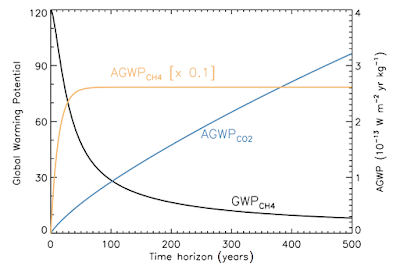I mentioned last week that methane is "100 times more powerful a GHG than CO2 on a pound for pound basis", There are a wide range of different statistics for it's potency as a GHG and this post hopes to summarise the main ones and explain where this suggestion of '100 times' came from.
There are many ways of looking at how effective a gas is as a GHG, the two most known methods being:
- A straight analysis of the gas' physical properties; how it behaves in the atmosphere, how much radiation of different wavelengths it is able to absorb etc. This method has its uses, but makes comparison with other gases GHGs which may behave in different ways difficult.
- A second, frequently used approach is a standardised measure, comparing all gases to the behaviour of benchmark gas CO2. This can be defined as "an index used to compare the relative radiative forcing of different gases without directly calculating the changes in atmospheric concentrations. GWPs are calculated as the ratio of the radiative forcing that would result from the emission of one kilogram of a greenhouse gas to that from the emission of one kilogram of carbon dioxide over a fixed period of time, such as 100 years." (US Energy Administration). Still a bit unsure about GWPs? Further explanation is available here.
The first working group on climate change created the GWP for their first report in 1995, they suggested then that methane had 21 times the GWP as CO2 over a 100 year time horizon, a figure which has been widely cited since. Their 1995 GWP statistics can be seen in Figure 1.
Figure 1
Source: IPCC AR2
Although the 1995 figures are still regularly cited today the understanding of methane's atmospheric residency time and its direct and associated indirect radiative forcings have improved since then. This has led to improvements in accuracy of the gas' GWP figures. Figure 2 shows the figures the IPCC Working Group 5 relied up in their most recent report (AR5) published in 2013.
Figure 2
Source: IPCC AR5, 2013
Whether cc fb (climate carbon feedback) is incorporated or not the more recent figures suggest that methane is in fact 50% more powerful a GHG as it was first thought to be in 1995, at least over the 20 and 100 year time horizons cited. The revisions in its strength as have been continuous and are shown in Figure 3 below:
Figure 3
Source: Author's own
Now returning to last week's claim that methane is '100 times more powerful than CO2 as a GHG'.
A bit of backward engineering of the data above hopefully should yield (simplified of course) a ball park figure which hopefully should suggest where figures such as the '100 times' are deducible from:
Working with the most recent AR5 data shown above...
-The lifetime of methane is said to be 12.4 years
-It's GWP over a 20 year horizon is said to be 86
-12.4 as a fraction of 20 years is 0.62
-86 / 0.62 is 138, suggesting that potency of methane is actually 138 times that of CO2.
Despite this being a highly simplified approach to working out the direct, immediate potency of methane compared to CO2 it does yield a very sizeable figure, and greater in fact than the '100' mentioned last week.
Perhaps though we should look to the climate experts for a more reliable, scientifically developed figure rather than one reliant on my simple maths! The AR5 report suggests that it is actually perhaps closer to a figure of about 120, this can be seen in Figure 4 by noting the intersect of the CH4 plot with the x-axis origin, depicting a time horizon of 0.
Figure 4
Source: IPCC AR5, 2013
So in short, a summary of this week's post:
- Data for the potency of methane as a GHG is improving, as is understanding into associated impacts of the gas in the atmosphere
- The GWP of methane on a 20 year horizon is now thought to be about 86 times that of CO2 and 34 times that on a 100 year horizon
- Considering the immediate potency of a molecule of methane as a GHG and its radiative absorption properties it can be said to be 120 times as potent as CO2








